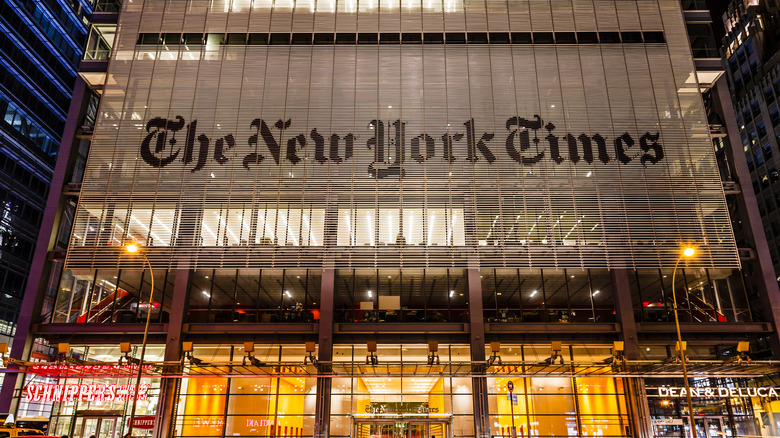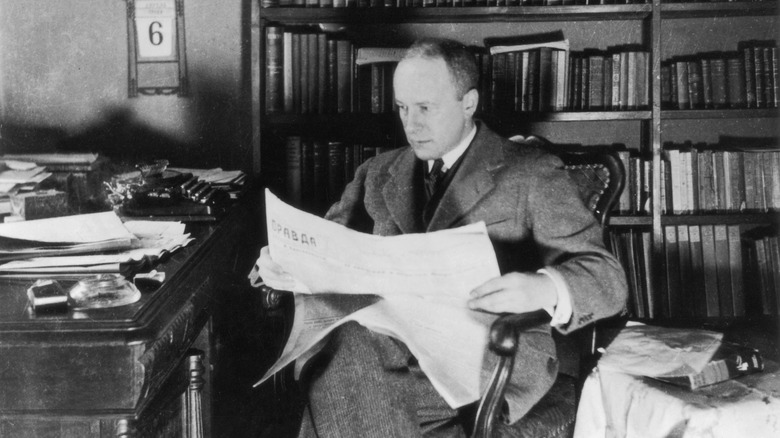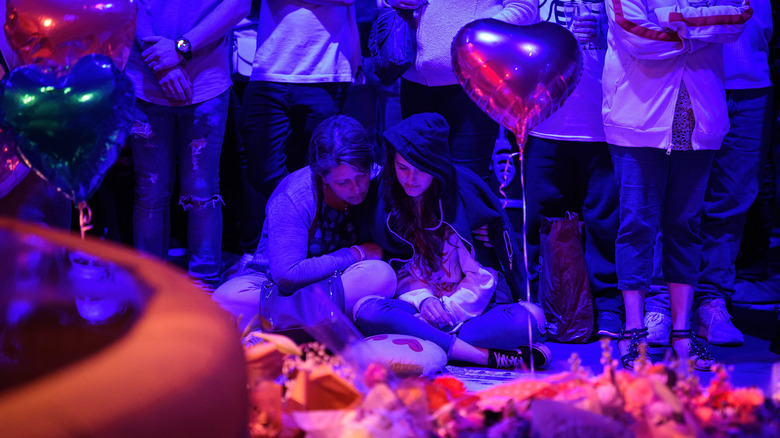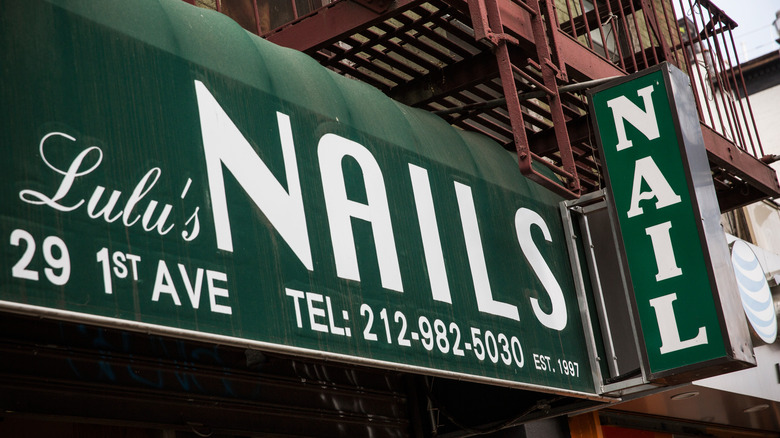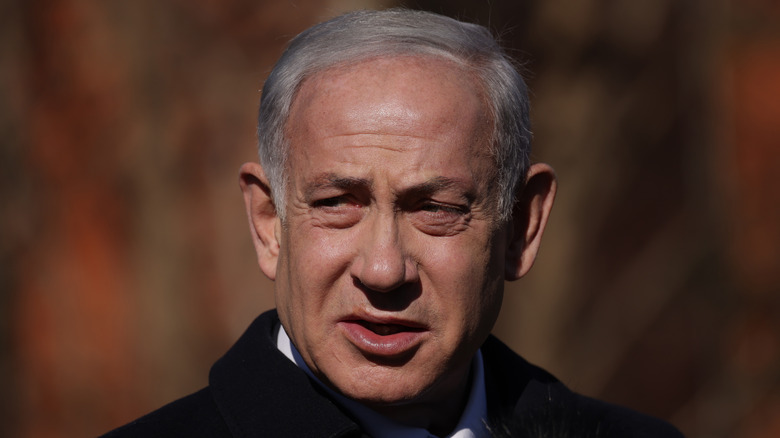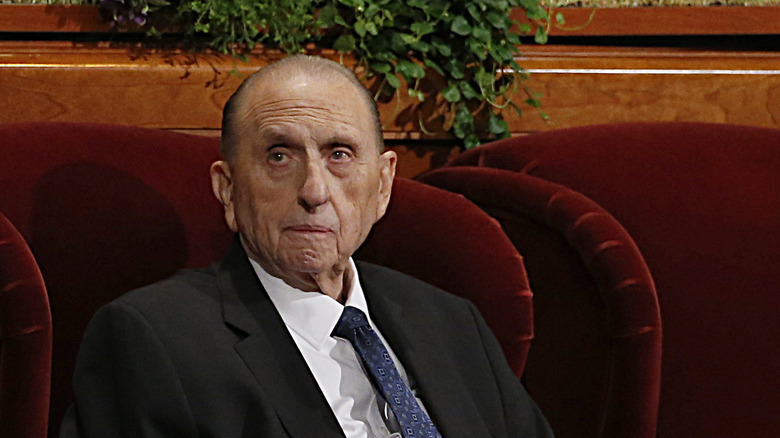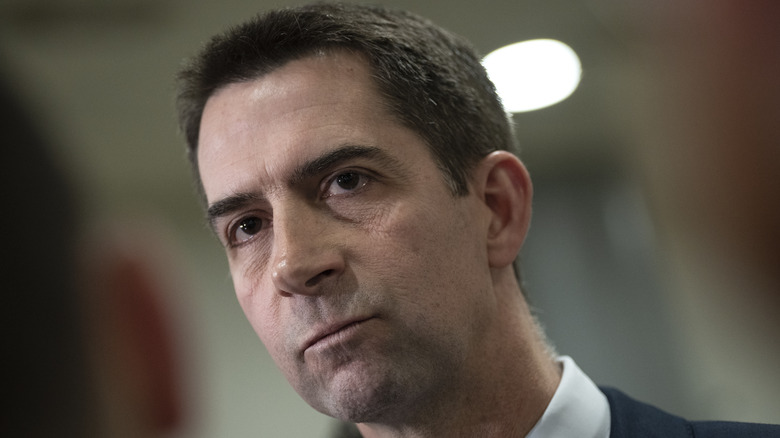The Biggest Controversies To Hit The New York Times
The New York Times is one of America's most venerated newspapers, and its international edition is widely read around the globe. As of 2022, the paper has received a stunning 132 Pulitzers Prizes for its grounding-breaking journalism. But with great journalistic power comes great responsibility; the stories that The New York Times tells have the potential to change the way we see the world. Little wonder then, that on occasions when the paper has printed misleading information or even outright lies, it has received some pretty damning criticism.
On the other hand, the paper is also often pilloried for its opinion pieces. The Times is sometimes characterized as left-leaning in its biases which comes in for heavy criticism; when it prints opinion pieces from the right of the political spectrum, it gets an equal amount of criticism from left-leaning readers. Today, the paper has countless scandals under its belt, created by political squabbles, unfortunate errors, and questionable editorial decisions.
Stalin defender Walter Duranty
British-born Times journalist and all-around scoundrel Walter Duranty won one of journalism's most prestigious awards — the Pulitzer Prize — in 1932. Yet despite his grand reputation, he had an unfortunate habit of printing lies.
Much of Duranty's work for The New York Times focused on life in the USSR, however, he primarily used government sources for his work. Taking the official Soviet line, he helped Joseph Stalin's monstrous regime cover up a series of atrocities, including the Holodomor famine in Ukraine. Although Duranty spent many years working in Moscow itself, he was tight-lipped about the reality of the famine that killed an estimated 10 million people. Duranty ignored the many millions of witnesses who could have confirmed the atrocities caused by Stalin's disastrous agricultural policies, and many of his comments read as grossly callous and insensitive; responding to reports by other journalists that people were dying en masse he brushed off any criticism of the dictator stating "you can't make an omelette without breaking eggs."
Although Duranty protected Stalin, it is generally believed that he was no communist; instead, he simply sacrificed his journalistic integrity to advance his career. His willingness to reprint propaganda gave him exclusive access to Stalin himself, access that put Duranty firmly in the spotlight. Despite the misgivings of other journalists and even his own editor, Duranty was widely celebrated for his work while he was alive. In modern times, however, The New York Times has acknowledged Duranty's failure as a journalist. The Pulitzer committee has never yet given in and rescinded his award, despite widespread calls to do so.
Underreporting the Holocaust
Although the Holocaust was perhaps the biggest tragedy of the 20th century, The New York Times made the bizarre decision to relegate the story to its back pages throughout the entirety of World War II. Although the paper was helmed by Jewish publisher Arnold Sulzberger at the time, the plight of Jewish people in Germany was frequently minimized. According to the Daily Beast, for example, news about the "Liquidation" of the Warsaw Ghetto was relegated to a small piece on page seven in 1942.
The extent to which the holocaust was ignored by the paper has been heavily scrutinized in recent times. Journalist Laurel Leff for example covered the issue extensively in her 2005 book "Buried by The Times" and an acclaimed documentary "Reporting on The Times" was produced a few years later. Both the book and the documentary speculate on the reasons for the downplaying of the Holocaust; Leff argued that Sulzberger was anti-zionist and wanted to prevent his paper from seeming too pro-Jewish, while the documentary argued that Sulzberger gave in to antisemitic sentiments in wider American society.
Writing for the History News Network, Leff notes that The Times and many other news organizations in the U.S. downplayed the Holocaust so much that by the end of the war, few Americans were even aware that it had even happened. The paper put the story on the front page just 26 times throughout the war.
The Manchester bombing photos
In 2017, The New York Times managed to cause an international incident by printing crime scene photos from the deadly Manchester terrorist bombing that killed 22 people. The scandal caused such an outrage on the other side of the Atlantic that Prime Minister Theresa May herself complained about the story and British police declared they would cease sharing top-secret data with the U.S. as a result of the article. The images showed debris from the scene including the remains of a blue backpack, destroyed in the explosion.
The photos were allegedly given to U.S. security services by the British and then leaked to the paper. New York Times editor Dean Baquet defended the decision to go to print by stating that they were neither violating anyone's privacy nor running any intelligence risks. Those who defended the decision, including Tom Collins writing for The Conversation, placed the blame on the mystery leakers rather than the press. Despite a flurry of angry emails from readers and the condemnation of the U.S. ambassador to the U.K., the paper maintained that the story was within the public's interest, giving Americans crucial information on how terrorists operate.
The swastika-shaped crossword
The New York Times has been embroiled in several antisemitism scandals over the years, but by far the strangest of them involved a crossword puzzle printed in 2022 that appeared to depict a swastika. Although it was actually at least the second time that a New York Times crossword had been noticeably swastika-shaped, by unfortunate coincidence on this occasion it was also printed on the first day of Hanukkah.
The negative space of the offending design so annoyed readers, scores of public figures, including President Donald Trump took to Twitter to complain about it. Worse still, that same weekend, the paper received a rinsing for its alleged history of antisemitism from Benjamin Netanyahu himself. He tweeted "After burying the Holocaust for years on its back pages and demonizing Israel for decades on its front pages, The New York Times now shamefully calls for undermining Israel's elected incoming government."
On the other hand, not everybody took the controversy terribly seriously writing it off as a coincidence or else laughing it off. New York Times Games tweeted "Yes, hi. It's NOT a swastika. Honest to God. No one sits down to make a crossword puzzle and says, "Hey! You know what would look cool?"
The Times promotes a fake Islamic State Jihadi
New York Times journalist Rukmini Callimachi appeared to have created a daring smash hit with her investigative podcast series "Caliphate," an attempt to get the inside scoop on the Islamic State group. Three of the 10 episodes were largely devoted to a series of interviews with Abu Huzayfah, a Pakistani-Canadian man who frankly confessed to being a cold-blooded killer, hired as a police executioner for the militant outfit. Huzayfah's story turned out to be a riveting one; the tale of a man who had been radicalized by hatred but who had ultimately returned to the West after partaking in an array of grisly horrors. Unfortunately, the story was pure fiction.
Callimachi herself noticed inconsistencies in her interviewee's story and before long Huzayfah was under investigation by the Canadian authorities, not for murder but for fraud. Crumbling under pressure, Huzayfah (real name Shehroze Chaudhry) confessed to fabricating the entire tale; he never joined the Islamic State group nor had he ever been to Syria. The hoax charges against him were dropped after he confessed, and he was ordered to remain under the watchful eye of his parents in Ontario for a year and take up counseling.
The entire debacle was an embarrassment for The New York Times, which came under scrutiny for the failure of its star reporter. Times editor, Dean Baquet confessed on NPR that the team's excitement over the story had clouded their judgment. The offending episodes were removed and The Times returned a Peabody award they had received for the show.
The New York nail salon protest
In 2015, The New York Times ran a two-part series exposing terrible working conditions in nail salons in New York City. The Times showed that the industry is rife with poorly documented migrant workers from East Asia, many of whom are barely paid or not paid at all. Their lack of English and precarious position as immigrants has enabled widespread abuse, resulting in thousands of salon workers being too frightened to complain about their treatment, all the while being forced to work insane hours, and exposed to noxious chemicals.
The two articles made for sobering reading, and were shocking enough to spur the city into action and conduct a thorough crackdown on the industry. In the months that followed, many salons were found guilty as charged and forced to pay back huge sums in stolen wages. A dire 40% of salons investigated in the crackdown were found to have paid less than minimum wage.
Yet not everyone saw The Times as heroic crusaders for justice. Disgruntled nail salon owners, outraged at the newspaper's claims began picketing The New York Times's offices. The protestors claimed that the incendiary articles had seriously hurt their livelihoods, that many of the claims made in the paper were lies, and that they were reluctant to ventilate their shops in line with new regulations. A number of journalists also responded negatively to the articles, including Jim Epstein, writing for Reason Magazine. Epstein claimed that upon examination the witnesses interviewed for the article were often misquoted and that their experiences did not represent the majority.
The 2001 anthrax attacks case
In 2001, shortly after the Twin Towers disaster, America was rocked by a series of sinister anthrax attacks in which envelopes laced with the deadly poison killed five Americans and made 17 others gravely ill. It would take many years before the real killer, Dr Bruce Irvins was finally identified, and in the meantime, an expert on biological weapons Dr. Steven Hatfill became a key suspect in the case.
Although in reality, Hatfill had nothing to do with the attacks, the scientist was publicly named and shamed, allegedly after the FBI leaked information about the investigation to the press. Previously known under the alias "Mr. Z," Times columnist Nicholas Kristof identified Hatfill indirectly by describing exactly who he was in great detail. Later, he named Hatfill and called for him to be pursued by the FBI.
After his name was cleared Hatfill sued both the U.S. Justice Department and The New York Times for identifying him as the killer, for causing him a great deal of distress, and for defamation. The judge threw out the case arguing that Kristof did not knowingly print lies. His case against the Justice Department was more successful — the long-suffering scientist was awarded $4.6 million in damages.
The anti-semitic cartoon
The New York Times International edition made a grave error in 2019 when it chose to reprint a notorious Portuguese cartoon that many people found offensive. The cartoon in question depicted Israeli politician Benjamin Netanyahu as a dog with a Star of David collar. Donald Trump, wearing a Jewish yarmulke — holds his leash.
Criticism flooded in from politicians and journalists around the world, from Israel to Germany, and protestors arrived outside The New York Times offices to show their anger. The Jewish American Committee was particularly scathing in response to the cartoon, responding to a hasty apology made by the paper via their Twitter account: "Apology not accepted. How many @nytimes editors looked at a cartoon that would not have looked out of place on a white supremacist website and thought it met the paper's editorial standards? What does this say about your processes or your decision makers? How are you fixing it?"
As accusations that the paper is anti-semitic resurfaced once again, The Times made the shocking decision to scrap their use of political cartoons altogether that June. The move caused almost as much controversy as the original cartoon did, sparking accusations that the paper was rolling back freedom of expression in a cowardly fashion.
The vitriolic obituary of Mormon President Thomas S. Monson
Former Mormon President Thomas Monson, who died at the age of 90 in 2018, was a divisive figure often at odds with the modern world. When he passed away, The New York Times sided firmly with the more negative assessments of his character, choosing to publish an obituary that focused strongly on his opposition to LGBTQ rights and his rejection of women priests.
Many people felt that Monson had dedicated his life to serving others, and should not have been so aggressively criticized in a piece commemorating his life. One of the most damning responses appeared in the National Review which noted, "Online commentators contrasted the tenor of The Times' obituary of Monson with the paper's more sympathetic tone for the likes of Hugh Heffner and Fidel Castro." It went on to argue that a more balanced piece would better serve the paper's progressive ideals than outright condemnation.
The Times received a flood of scathing letters about the article, some of which they published, along with a reasoned response. The paper concluded that although the piece could have been more well-rounded, Monson's political views were the part of his life of most interest to their readership.
Editor Erin Marquis leaves abusive phone messages
In 2021, The New York Times fired one of its editors, Erin Marquis, after she embarked on a personal crusade against gun ownership, leaving abusive voicemail messages at the offices of the National Association for Gun Rights. Marquis had been hired as the lead editor for The New York Times's product recommendation magazine Wirecutter but did not last long.
Several days before the incident occurred, a deadly school shooting had just taken place in Michigan at a local High School. Reacting to the grim turn of events the local Great Lakes Gun Rights group sent out press releases reaffirming their opposition to gun control, driving Marquis into a fury. The Washington Post reports that before leaving the messages Marquis tweeted, "Just got a news release from the Great Lakes Gun Rights organization about protecting gun rights from democrats in Michigan and I am literally shaking with rage." Her Twitter account has since been deleted.
Name-dropping The New York Times, she launched into a tirade over the phone, saying, "I'm just calling to wonder, I have two questions. How do you sleep at night? Aren't you just, like, a little bit worried that there might be a hell, and when you meet God he might send you there?" The gun group published the messages on YouTube in retaliation, sparking an inquiry into the editor's behavior.
Controversial and scientifically inaccurate reporting on transgender issues
Hundreds of concerned readers, including New York Times journalists, popular celebrities, and LGBTQ activists signed two separate open letters to The Times in 2023, complaining about the paper's coverage of trans issues. The critical letters argued that The Times has published a wave of articles on trans rights that are scientifically inaccurate and offensive, giving a voice to unsubstantiated claims that have no basis in fact. The signees' response was echoed by the Science-Based Medicine group, which noted that a recent Times article on the use of puberty blockers was misleading and had been collated by non-experts, despite its claim to be the result of extensive research.
Critics highlighted the power The New York Times holds to shape American mindsets and influence political decisions. Speaking to NBC News, Times contributor Jo Livingston commented "The New York Times seemed to be acting as this catalyst for speeding up outrage cycles and shuffling those hot-button issues into policy proposals." Livingston was one of 370 Times contributors to sign one of the letters.
Despite the uproar, the paper remained defiant. A Times spokesman claimed they were proud of the articles they had printed, and, the very next day published "In Defense of J.K. Rowling," defending the author whose comments on trans issues have themselves been heavily criticized.
Printing a call for military intervention during the George Floyd protests
The New York Times is known for printing controversial opinion pieces by guests from across the political spectrum, however, in 2020 it published a piece that so appalled its readers, senior editor James Bennet was forced to resign as a result. The piece, penned by Republican Senator Tom Cotton was written in response to the George Floyd protests that caused considerable unrest across the nation.
Cotton called for the president to use military force in his article, which was titled "Send in the Troops." The piece was swiftly condemned by critics as a fascist overreaction and many New York Times staffers were particularly aggrieved by the paper's decision to go to print. Perhaps the most damning response came from the News Guild of New York which pointed out that the piece not only encouraged violence, it spread misinformation about the protest and did not live up to journalistic standards.
Today, the online article now bears an apology at the start which notes "... given the life-and-death importance of the topic, the senator's influential position and the gravity of the steps he advocates, the essay should have undergone the highest level of scrutiny" (via The New York Times). It adds that the Senator's claims about the role of Antifa protestors during the riots were unsubstantiated.
